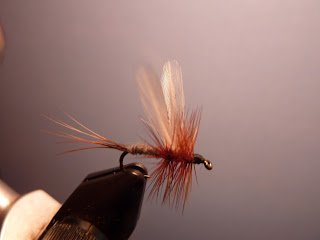Here's why you should care about aquatic flies, even if you're not a fly fisherman. The degree to which a body of fresh water supports strong populations of aquatic insects such as mayflies, caddisflies, stoneflies and dragonflies is generally an indication of the overall health of that body of water. The presence of the insects correlates to the presence of nutrients and desirable types of aquatic vegetation that is only possible when the water is free of harmful chemicals and invasive foreign species introduced by careless people. The absence of the insects generally correlates to unhealthy, unclean and intemperate conditions affecting the water. The insects serve as direct sources of food for large fish, or for the smaller fish and other aquatic animals that larger fish eat. They also feed birds and certain mammals. They are clear symbols of the overall quality of the ecosystems in which they reside, and everything in those ecosystems, ultimately including humans. So next time you visit a park or other area in which there is a river or a pond, look around to see if there are insects flying, or perhaps floating on the surface of the water or perched in the bushes and grasses near the water. If you see them, rejoice that they are there.
Sorry for the polemic, but I think it's important that we observe and appreciate the inherent worth of all living things and understand their place in the chain of life in which we humans are another of the links. With that said, I turn my attention back to the particular insects - little mayflies - that are one of the principal foods of Sierra trout, especially early in the season. As I discussed in my last blog, I'll be fishing for Sierra trout next week, so I've been tying flies for that purpose, including those pictured below. The pictures show two versions of a fly - the Adams - that is one of the most ubiquitous fishing flies in existence. The first version pictured below is tied with standing wings in imitation of a fully-formed "dun," or adult mayfly. When the fly is cast, the hackle feather that is tied around the hook next to the wings extends down in the water like the legs of a mature dun. Both of the flies below are tied on size 18 hooks - that is, they are very small, as are the actual mayflies we expect to see next week.
The Adams variant pictured below has a less prominent wing, and the hackle is tied around the wing post in a "parachute" style, which produces a fly that sits lower in the water and more closely resembles an emerging fly. An emerging fly is one that is in the last stage of transformation from its underwater larval, or nymph, form into its adult, dun, form. It has risen to the surface of the water and is still striving to unfold and dry its wings so that it can fly off the water before it is eaten by a fish. In my experience, trout tend to prefer the parachute-style flies and other emerger patterns over the dun imitations, probably because trout know that emergers are more vulnerable than duns, and therefore easier targets.
These flies have gray bodies, unlike the blue-winged olives that are likely to be hatching in the Sierra this time of year. But when tied very small, as these examples are, and because their shapes produce such strong impressions of real mayflies, they are usually as effective as other, more realistic flies I'll also use. Very few fly patterns have accounted for as many trout caught as has the Adams.





Don,
ReplyDeleteI sincerely enjoyed my first visit to your blog this evening. I appreciate your approach and am impressed with your writing talent.
I trust that you will have the time and energy to keep us posted on your journey this summer. Hmmm...on second thought.. maybe you'll find so many other exciting opportunities that you will need to wait until you return home to share your stories and write about it.
Looking forward to the sharing the opening weekend of the PA trout fishing season with you and your talent on the Bushkill Creek.
Jeff